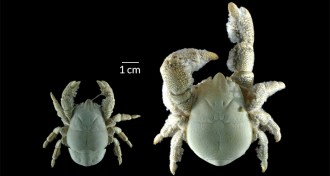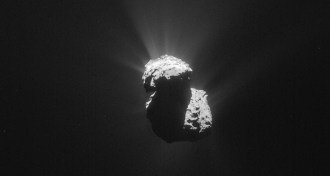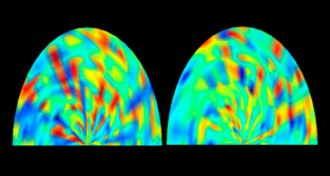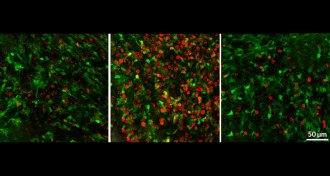All Stories
-
 Psychology
PsychologyThe guilty pleasure of funny cat videos
Many people love posting and looking at cute kitty content online. A new survey shows that this could be because it helps us manage our emotions.
-
 Health & Medicine
Health & MedicineSpit test could provide early warning of head, neck cancers
A new study shows that signs of head and neck cancer can be detected in saliva and blood plasma even before tumors are clinically diagnosed.
-
 Life
LifeHow vitamin B12 makes pimples pop up
Vitamin B12 causes acne by altering metabolism of skin bacteria.
-
 Animals
AnimalsNewly discovered yeti crab swarms around Antarctic hydrothermal vents
A newly discovered species of yeti crab thrives in tough conditions on Antarctic hydrothermal vents.
-
 Paleontology
PaleontologyFossil worm adds head to its spiny appearance
Hallucigenia sparsa gives hints to how some animals ended up with teeth in their guts and platelike pieces around their mouths.
-
 Astronomy
AstronomyDark galaxies grow in abundance
Nearly 1,000 shadowy galaxies lurk in a nearby cluster, some of which are as massive as the Milky Way and yet have only 0.1 percent the number of stars.
-
 Planetary Science
Planetary ScienceRosetta mission extended until September 2016
The Rosetta spacecraft will explore comet 67P through September 2016 and then may go to sleep on the comet’s surface.
-
 Plants
PlantsBeauty drives orchids towards extinction
Dozens of species of Asian slipper orchids have been newly classified as threatened or endangered, their numbers driven low by illegal trade.
-
 Astronomy
AstronomyMagnetic ‘glue’ helps shape galaxies
Galaxy-wide magnetic fields may play a role in shaping the spiral arms of gas and stars.
-
 Planetary Science
Planetary SciencePluto and Charon’s orbital dance captured in color
New Horizons has captured the first true-color movie of Pluto and Charon orbiting one another.
-
 Neuroscience
NeuroscienceSense of smell is strictly personal, study suggests
A new test can identify individuals based on their sense of smell, and may hold information about a person’s genetic makeup as well.
-
 Neuroscience
NeuroscienceBrain’s adult stem cells born early
By tracing the lineages of adult stem cells in the mouse brain, scientists get a view of the cells’ early lives.